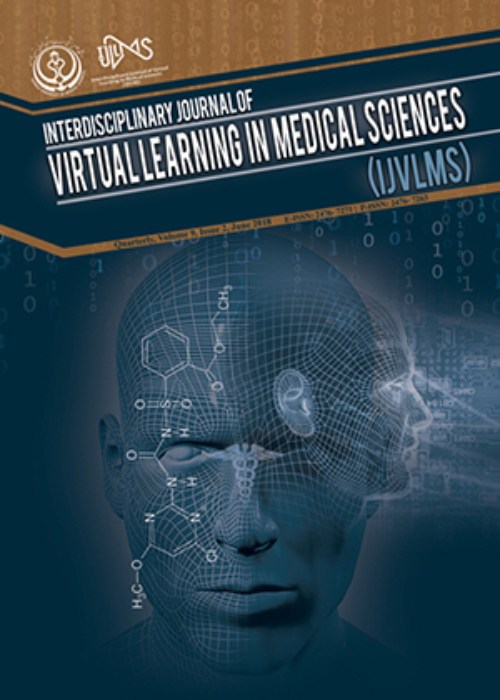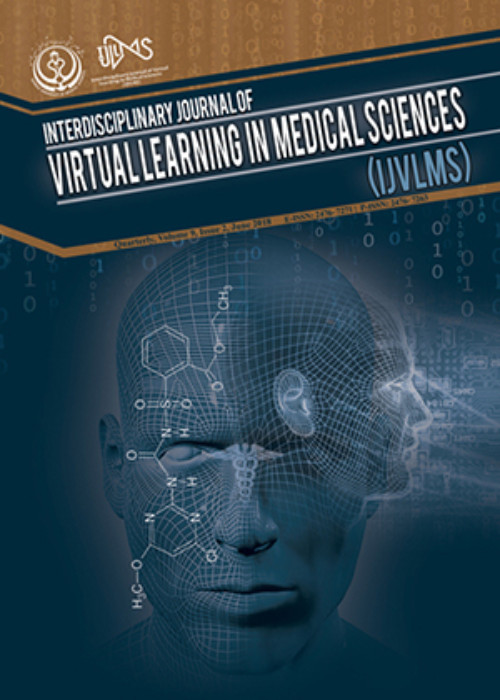فهرست مطالب

Interdisciplinary Journal of Virtual Learning in Medical Sciences
Volume:14 Issue: 2, Jun 2023
- تاریخ انتشار: 1402/06/02
- تعداد عناوین: 8
-
-
Pages 81-98Background
Intubation is a crucial procedure used to maintain an open airway in patients who are deeply sedated, unconscious, or under anesthesia. It enables controlled ventilation and administration of oxygen during surgeries, severe illnesses, extensive trauma, or following cardiac arrest. Difficult intubation poses a significant risk to patients’ well-being and necessitates comprehensive training programs for healthcare providers. With the rise of online teaching, it is essential to explore and understand the complications associated with difficult intubation to develop effective online training programs.
MethodsA literature review was conducted to examine the relevant literature on intubation complications and online teaching approaches. Electronic databases, including PubMed, Embase, and Scopus, were searched using keywords such as “intubation complications”, “difficult airway”, “online teaching”, and related terms. Studies published from January 2018 to September 2022 were included. The selection criteria focused on articles that addressed the complications of intubation, online teaching strategies, and their impact on healthcare provider training.
ResultsThe literature review identified 23 relevant studies that met the inclusion criteria. The findings highlighted the significance of understanding and addressing the complications associated with difficult intubation in online teaching programs. Various approaches were explored, including virtual simulations, video-based modules, and interactive online platforms. These methods demonstrated promising results in improving healthcare providers’ knowledge and skills related to intubation, ultimately enhancing the patients’ safety.
ConclusionThis literature review emphasizes the importance of integrating the complications of difficult intubation into online teaching programs for healthcare providers. The findings support the utilization of virtual simulations, video-based modules, and interactive online platforms as effective tools in enhancing training outcomes. Online teaching provides a flexible and accessible platform for healthcare providers to learn and practice intubation techniques in a simulated environment, thus improving their preparedness for real-life scenarios.
Keywords: Intubation, Ventilation, Corona, Patient, General anesthesia, Online teaching -
Pages 99-107BackgroundSignificant changes have occurred in education, including the emergence of E-learning which appeared to be an alternative method of carrying out teaching and learning activities. This research seeks to examine the correlation between Kolb’s learning styles and readiness for e-learning.MethodsThis cross-sectional study was conducted in Jiroft University of Medical Sciences (southern Iran) in 2021. 247 eligible medical students were selected using convenient sampling. Data were collected using the Watkins standard e-learning questionnaire and Kolb’s learning styles questionnaire. Data were analyzed by SPSS version 23 using descriptive and inferential statistics (ANOVA and post hoc LSD tests) which were all used to find connections. A P-value<0.05 was considered statistically significant.ResultsThe participants’ mean age was 21.5 (SD: 1.69) years and average score in the e-learning readiness tests was 127.54 (SD: 27.05). According the findings of this study, the learning style of most students was divergent (104 (42.1%)). One-way analysis of variance, showed that there was a statistically significant difference between the average e-learning readiness ratings for various learning styles (F=3.20, P=0.024). Converging style is the top favored learning style among students who are ready for online learning, according to researchers.ConclusionAccording to the findings of the study, students’ learning styles were statistically relevant to their readiness for e-learning. The study may be useful for a balanced pedagogical system in both pandemic and post-pandemic situations. University planners need to pay special attention to the students’ learning styles because one of the ways to increase preparation for e-learning is to know the students’ learning style.Keywords: Learning, education, Kolb’s learning styles, E-Learning, Medical Students, COVID-19, readiness
-
Pages 108-119BackgroundVocabulary learning is of paramount importance in language learning. Thus, effective ways of teaching new words are sought after by language teachers. This study aimed to investigate the effectiveness of three techniques of vocabulary teaching on learning and retention.MethodsInitially, 80 upper intermediate female learners of Iran Oxford institute in Tehran participated in this one sample time series quasi-experimental study. Based on the Oxford Online English -Vocabulary Level Test, 37 learners were qualified. In Summer 2021, they took part in the first phase and received the routine treatment. The same students took part in the first experimental group and received the non-etymological-based online game, although only 33 students turned up. In the last stage, the number of participants reduced to 30; therefore, the data analyses were done with 30 students. After each stage, a posttest and a delayed posttest (taken from Building English Vocabulary with Etymology from Latin) were administered. One way ANOVA and Scheffe’s Test were run to compare the groups.ResultsThe results indicated that the etymological game group outperformed (M=13.16, SD=1.17) the non-etymological (M=12.00, SD=2.33, P=0.04) and control groups (M=11.10, SD=1.53, P<0.001). Moreover, the difference between the non-etymological group and the control group was significant (P=0.048). In the delayed posttest, a significant difference was detected between the etymological game group and the control group (P<0.001). Besides, the etymological game group gained a significantly higher mean score mean score (M=12.40, SD=1.83) than the non-etymological game group (M=9.93, SD=1.99) (P<0.001). However, the non-etymological game group did not significantly outperform the control group (P=0.915).ConclusionThe results of post- and delayed post-tests indicated that the etymological game group had the best result followed by non-etymological game group.Keywords: Learning, education, Distance, Research, Game, Kahoot, Vocabulary, Etymological, non-etymological
-
Pages 120-129BackgroundUsing podcasts has long been the source of benefit in education. Podcasts are now used for learning and teaching; however, some aspects are still uncovered. Therefore, this study aimed to determine the effect of using podcasts as instructional tools on English as a Foreign Language (EFL) learners’ vocabulary knowledge and satisfaction towards listening to podcasts.MethodsIn this quasi-experimental study, a vocabulary pretest was given to 60 males intermediate EFL learners from Iran Language Institute (ILI) in Gonbad-e Kavus city, Iran, from October to November, 2017, to check their homogenity regarding their vocabulary knowledge. Then, they were divided into two experimental and control groups, each with 30 participants. The experimental group was instructed by the use of podcasts, but the control group continued with routine instruction. They were given a post-test to examine their knowledge of vocabulary. Also, to find out the students’ satisfactions towards podcasting, a 5-point Likert scale questionnaire with 8 items was given to the participants in the podcasting group. In addition to the Likert-scale questionnaire on their satisfaction, face-to-face interviews using probing questions were conducted with 8 participants. The collected data were analyzed through Statistical Package for Social Science (SPSS) version 20 using t-test. The p-value was considered at 0.05 level of significance.ResultsThe results revealed that the podcast group outperformed the control group in the post-test. The mean±SD for the control and experimental groups were 14.10±1.29 and 16.66±0.92, respectively (P=0.001). Then, the thematic analysis revealed four themes: (1) vocabulary achievement, (2) learning by listening, (3) learner choice and flexibility, and (4) podcasts as useful instructional tools.ConclusionsThe findings suggest that podcasts enhance learners’ vocabulary learning, thus emphasizing the pedagogical merits of podcasts in the enrichment of EFL classes. The results may provide implications for curriculum development and second language vocabulary teaching and learning.Keywords: Learning, education, Distance, Research, Information Technology, Vocabulary, Satisfaction
-
Pages 130-145BackgroundBy closing university and educational centers due to the pandemic outbreak of Coronavirus, E-learning achieved prominence. The technology advances in this field, moreover, have caused fundamantal changes in many approaches, including learning assessment methods. Therefore, this study aimed to identify the challenges of evaluating E-learning in the Coronavirus era and provide practical solutions for the optimal usage at the educational system in Iran.MethodsThis is a qualitative and research synthesis study. The inclusion criterion was the studies indexed in national and international databases, which were identified through a systematic search process. From 170 studies identified in the initial review stage, 100 were excluded from the analysis process due to the lack of sufficient information on the research objectives, repetitiveness, and unrelated research objectives. Then, in the content review, 70 researches were examined, and finally 20 studies which met the criteria for in-depth analysis were selected.ResultsThe analysis of the selected studies showed that there were key challenges in the E-learning assessment such as validity and reliability, lack of real measurement of learning results, lack of real interaction between students and professors, technological challenges, and heavy workload for the teacher and learner.ConclusionAccording to the results of the research, it is suggested that an agenda should be set in educational systems for the training the professors with applying and integrating the new tools and technologies in the assessment of the students’ learning.Keywords: Learning, education, Distance, Research, Evaluating challenges, coronavirus, Practical solutions
-
Pages 146-158BackgroundMedical students receive health information from various media sources and messages. Receiving health information can have a significant impact on the students’ dietary habits and healthy lifestyles. This study aimed to investigate the status of medical students’ use of health media and messaging, as well as the contextual variables that affect it.MethodsA survey study was conducted on 500 students of Shiraz University of Medical Sciences during September to December 2022 that were selected by simple random sampling. The research tool was a researcher-made questionnaire consisting of 15 items and six domains on a 4-point Likert scale, with a cutting point of 2.5. The validity of the tool was assessed using the CVI and CVR index, and its reliability was confirmed by internal consistency of 0.818. Data were collected through an e-questionnaire and analyzed using one-sample t-tests, independent t-tests, and ANOVA, using SPSS v.24 software.ResultsAbout 40% of the participants were male. 36.4% were BS students, 27.8% MD, 20.5% MSc degree, and the remaining were in the PhD program. 73.3% of the participants were single, 43.8% lived with their parents, and 28.8% lived in the dormitory. Among the types of health media, Internet searches (M=2.950), verbal conversations (M=2.394), scientific resources (M=2.236), and official health information websites (M=2.128) had the highest means, while mass media like radio and television were the lowest. Contextual factors such as age, field of study, place of residence, marital status, and educational level had a significant effect on the students’ preference (P<0.05), but gender had no significant effect (P>0.05).ConclusionStudents have access to the Internet and receive most of their information through this medium. Monitoring the sources and content of health information websites, as well as strengthening health media literacy among students, are of great importanceKeywords: Distance, Science, Health, Student, Medical, Messaging, Media, Preferences
-
A Review of the Book: Online Children and Their Right to Comprehensive Security in the Virtual SpacePages 159-162
Today’s children are the digital native generation and owners of the virtual space. With advances in technology and increased use of the internet, children are increasingly present in the virtual space. However, like any other phenomenon, the virtual space presents numerous challenges for children. Considering the importance of children’s rights in the virtual space, the author aimed to examine this topic from various dimensions. In this review, we analyzed and reviewed one of the books that examine children’s presence in virtual spaces from a legal perspective
Keywords: children, Right, Virtual Space, School, Violence -
Pages 163-167
Cardiovascular diseases are the number one killer worldwide, with 17.9 million deaths, and in Colombia, with 19,000 in the last quarter of 2022 (accounting for 30% of deaths). Despite healthcare services and educational programs, the epidemiology continues to grow steadily. Method 10 of Care as a Lifestyle, created by the Fundación Colombiana del Corazón (FCC) [Colombian Heart Foundation], aims to raise awareness to impact the perception of change and generate confidence to begin the pre-contemplation stage in peoples’ behavior, building a solid educational basis for introducing the concept of collective health to the community using simple and inclusive language, and adopting technological advances as a teaching medium. This refers to ludic and inspiring activities which help promote behavior change which aimed at building care into peoples’ lifestyles. The FCC proposes it as an apt pathway for preventing and/or reducing the incidence of cardiovascular disease by directing their actions more precisely toward clinical and social risk factors.
Keywords: Distance, Health Literacy, Collective health, Public Health, Health education, Lifestyles, Cardiovascular prevention, Cardiovascular disease


